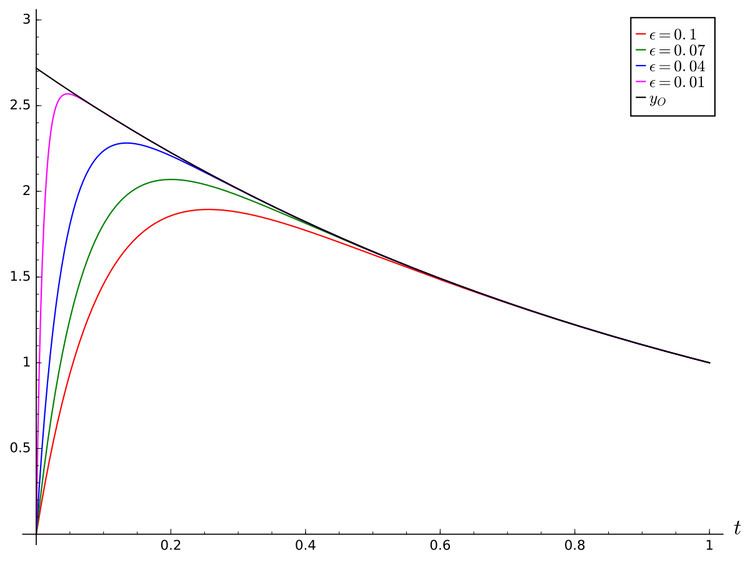 | ||
In mathematics, the method of matched asymptotic expansions is a common approach to finding an accurate approximation to the solution to an equation, or system of equations. It is particularly used when solving singularly perturbed differential equations. It involves finding several different approximate solutions, each of which is valid (i.e. accurate) for part of the range of the independent variable, and then combining these different solutions together to give a single approximate solution that is valid for the whole range of values of the independent variable.
Contents
Method overview
In a large class of singularly perturbed problems, the domain may be divided into two or more subdomains. In one of these, often the largest, the solution is accurately approximated by an asymptotic series found by treating the problem as a regular perturbation (i.e. by setting a relatively small parameter to zero). The other subdomains consist of one or more small areas in which that approximation is inaccurate, generally because the perturbation terms in the problem are not negligible there. These areas are referred to as transition layers, and as boundary or interior layers depending on whether they occur at the domain boundary (as is the usual case in applications) or inside the domain.
An approximation in the form of an asymptotic series is obtained in the transition layer(s) by treating that part of the domain as a separate perturbation problem. This approximation is called the "inner solution," and the other is the "outer solution," named for their relationship to the transition layer(s). The outer and inner solutions are then combined through a process called "matching" in such a way that an approximate solution for the whole domain is obtained.
A simple example
Consider the boundary value problem
where
Outer solution, valid for t = O(1)
Since
Alternatively, consider that when
This has solution
for some constant
Inner solution, valid for t = O(ε)
In the inner region,
which, after multiplying by
Alternatively, consider that when
This has solution
for some constants
Matching
We use matching to find the value of the constant
Composite solution
To obtain our final, matched, composite solution, valid on the whole domain, one popular method is the uniform method. In this method, we add the inner and outer approximations and subtract their overlapping value,
Note that this expression correctly reduces to the expressions for
Accuracy
This final solution satisfies the problem's original differential equation (shown by substituting it and its derivatives into the original equation). Also, the boundary conditions produced by this final solution match the values given in the problem, up to a constant multiple. This implies, due to the uniqueness of the solution, that the matched asymptotic solution is identical to the exact solution up to a constant multiple. This is not necessarily always the case, any remaining terms should go to zero uniformly as
Not only does our solution successfully approximately solve the problem at hand, it closely approximates the problem's exact solution. It happens that this particular problem is easily found to have exact solution
which has the same form as the approximate solution, by the multiplying constant. Note also that the approximate solution is the first term in a binomial expansion of the exact solution in powers of
Location of boundary layer
Conveniently, we can see that the boundary layer, where
Harder problems
The problem above is a simple example because it is a single equation with only one dependent variable, and there is one boundary layer in the solution. Harder problems may contain several co-dependent variables in a system of several equations, and/or with several boundary and/or interior layers in the solution.
It is often desirable to find more terms in the asymptotic expansions of both the outer and the inner solutions. The appropriate form of these expansions is not always clear: while a power-series expansion in
Second-order differential equations
A method of matched asymptotic expansions - with matching of solutions in the common domain of validity - has been developed and used extensively by Dingle and Müller-Kirsten for the derivation of asymptotic expansions of the solutions and characteristic numbers (band boundaries) of Schrödinger-like second-order differential equations with periodic potentials - in particular for the Mathieu equation (best example), Lamé and ellipsoidal wave equations, oblate and prolate spheroidal wave equations, and equations with anharmonic potentials.
